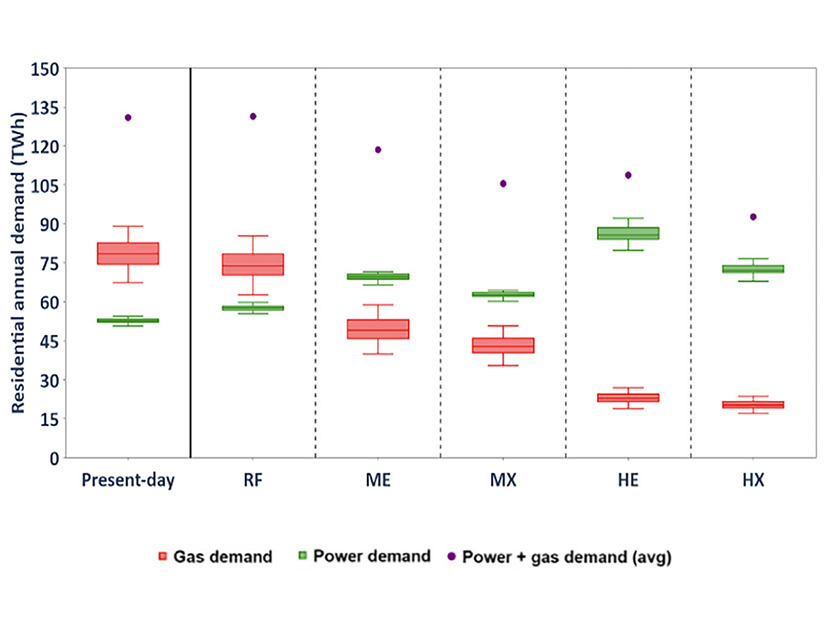
While heating electrification in New England is poised to drive a major increase in peak demand, electrifying about 80% of households could reduce the combined cost of the region’s electric and gas systems by 21 to 29%, according to a new study by researchers at the Massachusetts Institute of Technology (MIT).
The researchers emphasized the cost savings associated with retrofitting buildings to improve heating efficiency, noting that building envelope upgrades reduced electricity demand by an average of 16% in high-electrification scenarios and reduced gas demand by about 11%.
They also stressed the importance of coordinated planning between the gas and electric systems to minimize the overall costs.
“Our results highlight the value of integrated power-gas planning in future decarbonized energy systems, particularly in regions like New England where [natural gas] is prevalent as a heating fuel and also currently plays a major role in electricity supply,” the authors wrote. (See New England Gas Generation Hit a Record High in 2024.)
The researchers evaluated five electrification pathways for 2050 across the gas and electric systems. They modeled supply costs and the need for new infrastructure, including transmission and generation, and accounted for the impacts of weather variability and emissions limits aligned with state policies.
Across all scenarios, high electrification coupled with building heating efficiency improvements produced “the lowest combined residential power and gas demand that is up to 28 to 30% lower than values in the year 2020,” the study found.
The model indicated that higher levels of electrification would reduce natural gas consumption and gas system costs, along with demand for expensive low-carbon fuels. While electrification would increase costs for the power system, it would bring significant savings on the gas side, the authors noted.
“This highlights the importance of joint energy system planning and indicates that evaluating the gas or power systems in isolation from each other can lead to misleading results,” they wrote.
To meet the increased demand from residential electrification, the study’s power production model relied heavily on new onshore and offshore wind resources, in part due to their high capacity factor relative to solar resources. The study also found a significant need for dispatchable resources, mirroring the findings of a recent ISO-NE study on deep decarbonization. (See ISO-NE Study Lays Out Challenges of Deep Decarbonization.)
“At 17.7–28 GW, the overall capacity of the fleet of gas power plants is roughly 1 to 57% larger than the existing capacity but makes up only 8.4 to 13.4% of overall generation as compared with 52% for New England in 2022,” the authors noted.
However, the role of natural gas was reduced when methane leaks were factored into the calculations for the emissions constraint. Methane, which is an extremely potent greenhouse gas over short-term periods, is a major source of emissions from natural gas networks.
“Across all scenarios, accounting for methane emissions in the modeled decarbonization target leads to reductions in [natural gas] and increasing use of lower emissions-intensive but expensive [low-carbon fuel], thus increasing the total system cost,” the study found.
The authors found that including methane leaks into the emissions calculations increased the cost benefits of the high-electrification scenarios, which rely the least on natural gas. Accounting for natural gas leaks also increased demand for low-carbon fuels to meet decarbonization requirements.
“A theme of our findings is that a flexible, low-carbon electricity resource and/or low-carbon energy carrier will likely be needed to supply the energy demands of electrification cost-effectively while meeting decarbonization objectives in cold climates,” the authors wrote.
The model allowed for additions of resources reliant on low-carbon fuels or carbon capture and storage. The authors noted that “competing technologies like nuclear-based power generation and long-duration energy storage could also be equally important to consider,” though these technologies were not modeled in the study.
They also acknowledged there is uncertainty around the cost, availability and lifecycle emissions of low-carbon fuels, and similar viability concerns for natural gas generation with carbon capture and storage.
The study, which sheds light on combined costs from the bulk power and gas systems, should not be interpreted as an all-encompassing cost-benefit analysis for heating electrification. It does not compare costs at the distribution level and does not account for the installation costs of end-use equipment or building retrofits.
The authors highlighted the need for more research into commercial sector electrification, demand flexibility and distribution system impacts.


